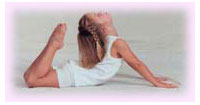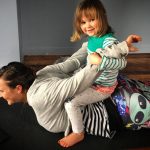The power of yoga to improve the quality of life for our children is an untapped resource.
by guest author Amanda Reid of Samadhi Yoga
Although yoga has enjoyed popularity with adults for many years, it is only recently that we have come to understand how helpful it can be for children in their formative years, increasing their self-awareness, building their self-esteem, and strengthening their bodies – truly a welcomed oasis in a culture that offers little in the way of mindful yet active play.
The key word is play – children care mostly about having fun, as I’ve discovered through parenting and teaching. Adult yoga can be as serious as a person makes it, but children’s yoga has got to be fun!
The mental alertness that doing yoga brings helps both at school and at play. Parents will appreciate how a regular yoga practice enhances self-discipline in their children in much the same way that martial arts do. There’s a good chance that adding yoga to your child’s life will add relief to yours when, for example, it’s time for getting them to do what they need to and not do what they shouldn’t!
Create a special time and place:
Doing yoga together creates a meaningful ritual. Some families like to do it first thing in the morning for the best possible start on their day. Instead of reaching for that cup of coffee to dispel the mental fog, sit down and reach for your ankles. Loosen your spine by stretching it forward. Do a few neck rolls, and breathe deeply! By focusing on the inhale and exhale in rhythm with the movement of each exercise, both adults and children can experience the refreshing awareness of just plain being alive.
Practice a 15-20 minute routine in the morning and you will be surprised at how efficiently yoga grants alertness and gives a sharp, decisive mental attitude, all without the harmful effects of caffeine! On the contrary, most people who practice yoga daily feel calm, relaxed, and mentally alert.
Some families find that the evening is the best time for yoga together. Sitting in the soft light of a candle, the breath slows down and becomes conscious. Both parent and child drop the busy day in the remembrance of what is really important in their lives. Everyone slows down and feels more sensitive to each other. Good-night hugs and kisses are more special than ever.
Many sleep issues such as insomnia and night-time fears can completely disappear after beginning a routine of evening yoga. Exercises such as cat/cow, flexing the spine while on the hands and knees, will loosen the spine and relax it for restful sleep.
When to begin?:
At what age can children begin yoga? I started my daughter as an infant! Her tiny legs were gently bicycled, her arms moved up, down, and crossed over her chest. As a chattering kindergarten kid, she closed her mouth (occasionally!) and became aware of her breath coming in and out. With her eyes closed, she felt herself from the inside out. For my daughter it’s been a way of life, natural as breathing, with the feeling that ‘I can handle anything today!’.
If you do yoga already, begin to teach your child some simple exercises. Keep each exercise at 20 seconds for young ones, and up to one minute long for primary school aged children.
Remember the number one requirement: It’s got to be fun!
And if yoga is a new idea to you, why not begin along with your children? As many parents of my young yoga students have discovered, it works on us “big kids” too!
Amanda Reid discovered the joy and immense benefits of Yoga in 1992 and has been teaching since 2000. She is now taking registrations for her Radiant Child® Yoga Program (RCYP) – a comprehensive training program designed for anyone who is interested in teaching children yoga.
Amanda has teaching qualifications in Integral, Satyananda and Kundalini Yoga, Basic Certification and Advanced Levels 1 and 2 of Yoga for the Special Child programme, and Radiant Child Yoga (RCYP1-3 and international facilitator training). She is an E-RYT200 Yoga Alliance teacher and member of the International Association of Yoga Therapists. Amanda is also an Infant Massage Instructor, massage therapist and naturopath. She uses complementary therapies, body therapies and Yoga to support infants and children with special needs, pregnant women in conscious birthing and parenting, and adults with chronic health conditions.
Amanda teaches RCYP workshops in New Zealand, the UK, Ireland, and South East Asia (including Hong Kong, Malaysia and Vietnam), leads Yoga and Ayurveda retreats, and facilitates a RYT200 teacher training program in New Zealand, Australia and the UK specialising in Yoga from pregnancy to teens.


[…] How to introduce your children to yoga […]